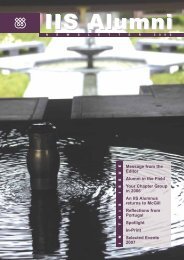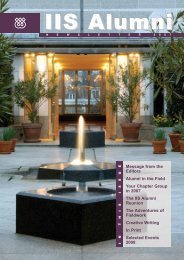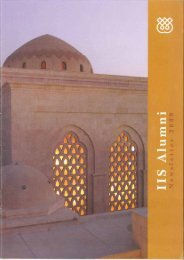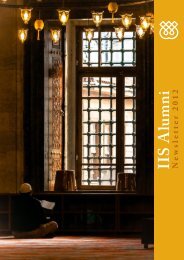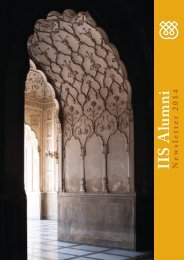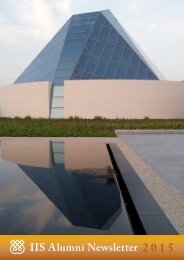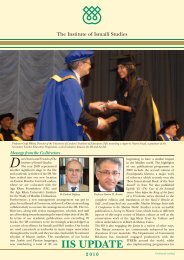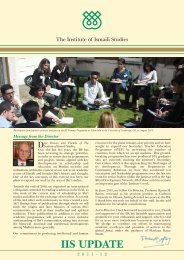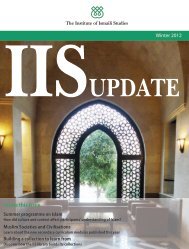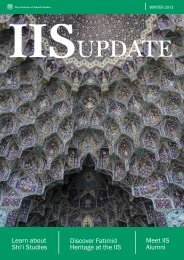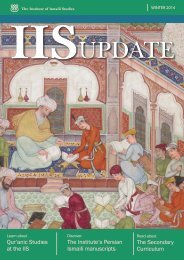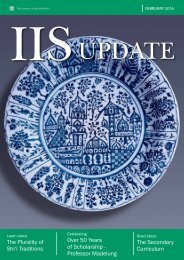IIS Update - Edition 17
IIS Update - Edition 17 The Institute has been publishing an annual IIS Update since 2000, to inform its supporters, affiliates and well-wishers of its programmes and activities. The IIS Update includes information about the Institute’s recent and forthcoming projects, as well as news about its publications and staff.
IIS Update - Edition 17
The Institute has been publishing an annual IIS Update since 2000, to inform its supporters, affiliates and well-wishers of its programmes and activities. The IIS Update includes information about the Institute’s recent and forthcoming projects, as well as news about its publications and staff.
You also want an ePaper? Increase the reach of your titles
YUMPU automatically turns print PDFs into web optimized ePapers that Google loves.
THE INSTITUTE OF ISMAILI STUDIES UPDATE<br />
The Contents of the Volumes<br />
The module consists of two volumes.<br />
The first volume – which was<br />
published in 2014 – covered the<br />
period between the eleventh and<br />
thirteenth centuries, focusing on:<br />
the rise of the Saljuq dynasty; the<br />
Ismaili da‘wa as it developed in<br />
Persia, Syria, and Central Asia; and<br />
the engagements of Muslims with<br />
the Crusaders and the Mongols.<br />
The second volume covers significant<br />
developments which occurred<br />
in Muslim regions in the post-<br />
Mongol period. These include the<br />
growth of a global trade system<br />
and the rise of various empires,<br />
including those of the Ottomans,<br />
the Safavids, and the Mughals.<br />
The volume also continues with the<br />
exploration of the diverse expressions<br />
of Islam in various parts of Asia and<br />
Africa. The history of the Ismaili<br />
Imamat and Ismaili communities<br />
in different periods forms an<br />
important part of both volumes.<br />
The Three Units:<br />
1 2 3<br />
Exchanges across Continents<br />
Introducing some of the major events<br />
of the thirteenth and fourteenth<br />
centuries, the unit includes the history<br />
of the Ismaili Imams and communities<br />
following the capture of Alamut by<br />
the Mongols. Also explored here<br />
is the rise of the Timurid Empire in<br />
this period. Another topic examined<br />
in this unit is the ancient trading<br />
routes, collectively known as the Silk<br />
Road, which were largely controlled<br />
by networks of Muslim traders.<br />
This exploration is extended to<br />
cover the Indian Ocean and Trans-<br />
Saharan trade routes. Students are<br />
led to examine the role played by<br />
Muslim merchants, scholars, artisans<br />
and preachers in the transmission<br />
of Islam along these routes.<br />
The Ottomans and the Safavids<br />
Beginning with the establishment and<br />
development of the Ottoman Empire,<br />
this unit pays particular attention to<br />
the period of Suleyman, the sultan<br />
under whom the Ottomans are said<br />
to have reached their peak. The<br />
relationships that developed during<br />
this time between European nations<br />
and the Ottomans are also analysed.<br />
The unit proceeds to examine the<br />
Safavids as the rulers of another major<br />
empire of this period. It traces the<br />
emergence of the Safavid movement,<br />
founded by the Sufi religious leader<br />
Shaykh Safi al-Din Ardabili. The<br />
movement gave rise to the Safavid<br />
dynasty, which became a powerful<br />
political force in Persia, and which<br />
established Shia Ithna Ashari Islam as<br />
the religion of the state.<br />
Empires in Transition<br />
The final unit of the module begins<br />
by examining the re-emergence of<br />
the Ismaili Imams in the fifteenth<br />
century in Anjudan, in Persia. Of<br />
significance here is the revival of<br />
Nizari Ismaili literature as reflected<br />
in the writings of the Imams and<br />
da‘is. Also covered here is the<br />
Ismaili Satpanth tradition in South<br />
Asia, and its relation to the genre of<br />
religious lyrics known as the ginans.<br />
The study broadens to trace<br />
the origins of the Mughals and the<br />
expansion of their rule in the<br />
Indian subcontinent and parts of<br />
Afghanistan. A review of Emperor<br />
Akbar’s rule leads to an exploration<br />
of Mughal art, architecture,<br />
scholarship, trade and diplomacy,<br />
and relationships between religious<br />
communities based on the principle<br />
of social harmony.<br />
Explore further<br />
Continue your learning journey by visiting the <strong>IIS</strong> website at www.iis.ac.uk<br />
where you can find accessible articles and a number of reading guides on<br />
books exploring aspects of Muslim history and civilisations.<br />
7



